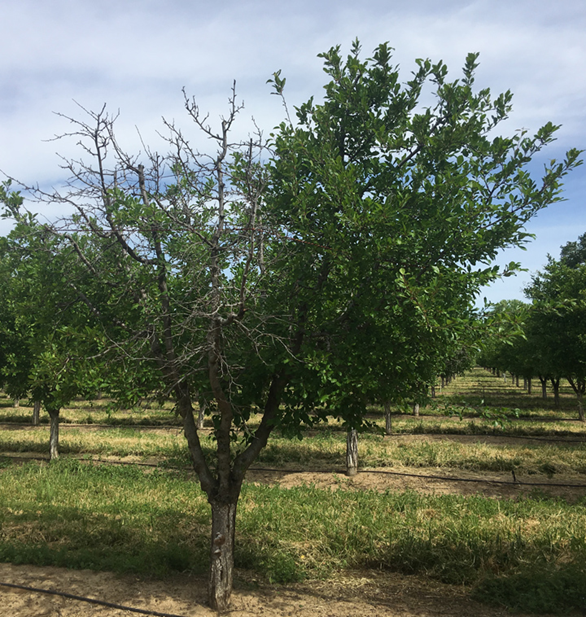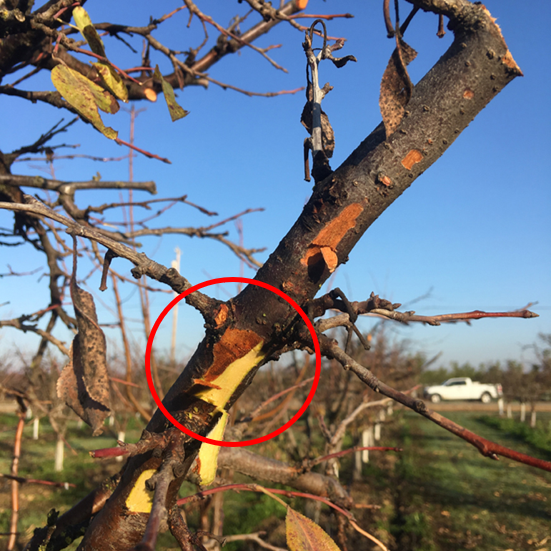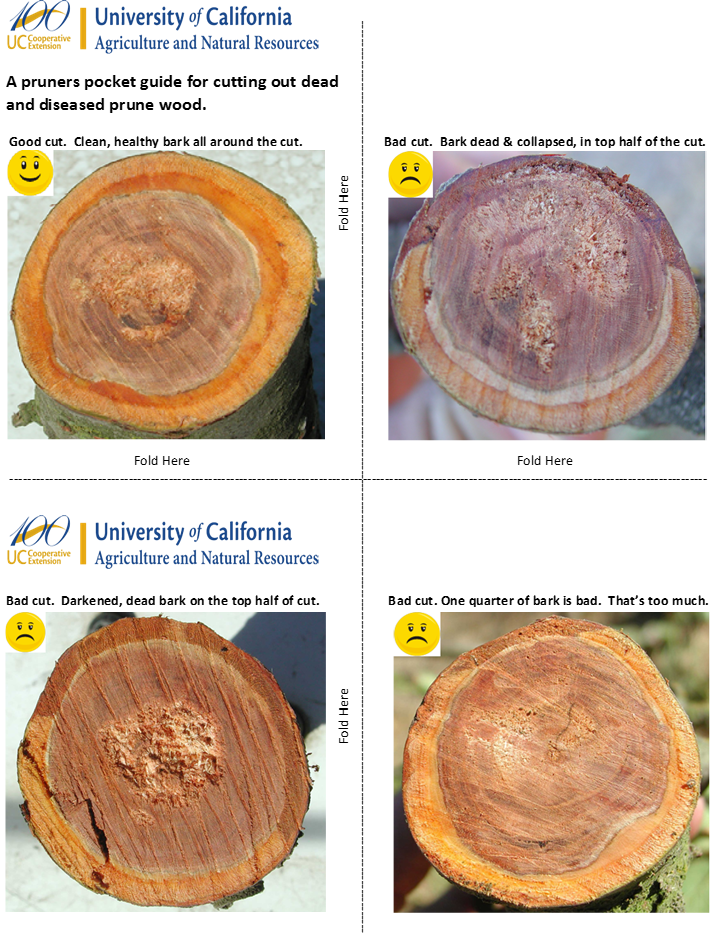Luke Milliron, UCCE Farm Advisor Butte, Glenn, and Tehama Counties
Franz Niederholzer, UCCE Farm Advisor Colusa, Sutter, and Yuba Counties

Photo 1. Cytospora canker damaged ‘French’ prune tree (photo by Franz Niederholzer).
Cankers caused by fungi of Cytospora spp. can severely limit prune production; reducing grower income and potentially leading to early orchard removal due to scaffold and/or tree loss (see Photo 1). In recent years there has been a dramatic increase in this disease in some orchards. Because the disease is widespread and infections persist year-after-year, integrated Cytospora management needs to be part of every prune grower and PCAs activities each year.
1. Protect pruning wounds.
Problem: Rain and wind splashed spores can infect unprotected pruning wounds. Infections can occur anytime rain occurs, wounds are open and disease spores are present. However, the first good rainstorm of the season may produce an especially large spore release, as the spores build up in diseased wood over time and cannot be released without rain.
Solution: Pruning wounds are vulnerable to infection for at least 30 days after the cuts were made, although the vulnerability is greatest in the first 15 days after pruning. Field work has documented that 1Topsin®-M fungicide (now with a 2EE label for pruning wound protection), applied directly to pruning wounds within a week of pruning, can reduce canker incidence. To-date, other fungicides tested have not delivered the same, consistent results as Topsin®-M.
2. Cut out diseased wood.
Problem: Unless it’s cut out, Cytospora cankers can continue to kill the infected tree with canker growth year-after-year. As an insult to injury, existing cankers also spread the disease to new trees by producing spores that will be rain and wind splashed in the next big storm event.
Solution: The first step in stopping Cytospora spread by cutting out diseased wood begins in identifying infections (see photo 2). In addition to pruning wounds, sunburn injured bark, borer damage, and other mechanical wounds (i.e. hail, oil burn, etc.) are all among the many potential sources of infection. You can look for brown Cytospora canker lines by cutting the bark with a pocket knife (photo 2).
As pruners remove dead and diseased wood – inspect cuts to ensure that they have cut clear into healthy wood, cutting the branch/shoot 2 inches below the external canker margin (figure 1). If pruners leave any canker, the canker may continue to spread in that tree and provide inoculum to infect additional trees. Of course removing diseased wood creates new pruning wounds that could themselves become infected – which is why this is best done in summer or early fall. If there is a chance of rain in the 30 days after pruning out dead and diseased wood consider protecting pruning cuts with 1Topsin®-M fungicide (see #1 above).

Photo 2. Pruning cut (upper right corner) that missed getting all the canker (inside red circle). It will keep growing down the branch (photo by Franz Niederholzer).

Figure 1. Pruners pocket guide for cutting out dead and diseased prune wood. Pay close attention to darkened brown bark (outermost band of cut branch) and keep cutting until the bark is healthy all around the cut (see upper left).
3. Invest in maintaining healthy trees. Cytospora preys on the weak.
Problem: Stressed prune trees are more susceptible to Cytospora canker infection and existing cankers will spread more rapidly in stressed trees. Whether because of tough economics, drought, or other factors – it’s easy for trees to become stressed and predisposed to Cytospora canker infection and spread. Specifically, the lab of Dr. Themis Michailides (UC Davis Plant Pathologist) has shown that cankers spread fastest in severely drought stressed trees. Water stress, potassium deficiency, mites, aphids, and rust can all lead to defoliation which allows for sunburn, another potential entry for Cytospora canker. Finally, weaker trees are more prone to borers and other wood-attacking insects that create additional entry points for the disease.
Solution: Adequate orchard soil moisture in late summer and early fall is one of the main ways to invest in maintaining healthy trees. One key practice to achieve this is taking stem water potential (SWP) readings with a pressure chamber to avoid the canker spread inducing severe water stress in late summer and early fall. Post-harvest irrigation should recover the trees to mild- to moderate-stress (-12 to -16 bars SWP) in-order to not reduce photosynthesis and disrupt carbohydrate allocation to storage leading into overwintering. An alternative to the pressure chamber are soil moisture sensors.
A second way to invest in healthy trees is to not skimp on potassium (K) fertilizer. Maintain a regular drip fertigation or fall banded program based on a combination of July leaf sample results, visual symptoms, and the amount of fruit harvested this year. Alternatively, a ground applied K program can also be supplemented with foliar applied potassium nitrate (KNO3) in spring and early summer. Prune newsletter orchard tasks published in each issue detail other key best practices for each season of the year that limit tree stress and defoliation and make for a healthier and more resilient orchard.


Leave a Reply